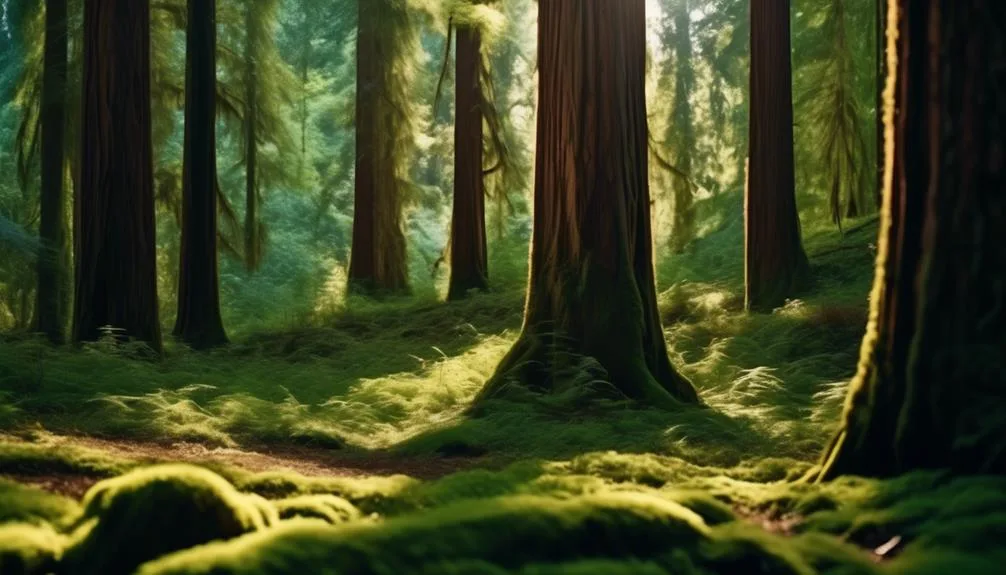Ever strolled through a magnificent redwood forest and gazed up at the towering trees? You might have wondered if these giants can thrive in the shade of their own canopies. It's not a simple answer.
While redwoods prefer sunlight, they have surprising abilities to adapt to shade. Understanding how they balance their need for light and their potential for shade tolerance is key to unlocking the mysteries of redwood growth.
Redwood Trees and Shade
In the shade of the towering redwood trees, the forest floor is a cool and tranquil oasis, sheltered from the harsh sun by the canopy above.
Redwood trees have remarkable shade adaptation, enabling them to thrive in low light conditions. Their foliage is efficient at capturing what little light penetrates the dense canopy, allowing them to photosynthesize and grow even in shade.
These trees employ various strategies to cope with light competition, such as shedding lower branches to minimize self-shading and redirecting energy to the upper canopy. This efficient use of limited light resources enables redwoods to maintain their impressive height and size even in shaded environments.
Understanding their shade adaptation and light competition mechanisms provides valuable insight into the resilience and success of these majestic trees in diverse forest ecosystems.
Shade Tolerance of Redwood Trees
Thriving in the cool, shaded refuge beneath the towering redwood trees, their remarkable shade adaptation enables them to maintain their impressive height and size even in low light conditions. Redwood trees exhibit high shade tolerance, allowing them to thrive in the shadows of their towering neighbors. Their ability to photosynthesize efficiently in low light contributes to their survival in shaded environments. While redwood trees prefer full sun, they can tolerate shade, especially when young. However, to reach their full potential, providing optimal growing conditions with partial to full sun exposure is essential. Here's a table summarizing the optimal growing conditions for redwood trees:
| Optimal Growing Conditions | Description |
|---|---|
| Sun Exposure | Partial to full sun |
| Soil Conditions | Well-drained, moist soil |
| Watering Needs | Regular watering, especially in dry periods |
| Climate Conditions | Mild temperatures, moderate humidity |
Factors Affecting Redwood Tree Growth in Shade
Under the canopy of redwood trees, several key factors influence the growth of these majestic giants in shaded environments. Redwood trees possess remarkable shade tolerance due to various influencing factors.
One crucial factor is soil composition. Redwood trees thrive in well-drained, acidic soils, which are abundant in the shaded environments beneath their own canopies.
Additionally, the availability of nutrients and water in the soil significantly impacts their growth in shade. Redwoods have evolved to efficiently extract essential nutrients and moisture from the soil, enabling them to thrive in shaded conditions.
Another essential factor is competition for resources. Redwood trees have developed mechanisms to effectively compete with surrounding vegetation for sunlight and nutrients, further enhancing their shade tolerance.
How to Help Redwood Trees Thrive in Shade
To enhance the thriving of redwood trees in shaded environments, consider strategically managing the surrounding vegetation and soil composition. Redwood trees have remarkable shade adaptation capabilities, but they still benefit from some assistance.
Start by clearing out any competing vegetation around the base of the tree. This will allow more light to reach the lower branches and aid in the tree's overall growth. Additionally, pruning the lower branches can help redirect resources to the tree canopy, where they're needed most.
When it comes to soil composition, make sure it's well-draining and rich in organic matter. Redwoods thrive in slightly acidic soil, so consider adding a layer of organic mulch to maintain the appropriate pH level.
Conclusion: Redwood Trees and Shade
In shaded environments, redwood trees demonstrate remarkable adaptation capabilities, which can be further enhanced with strategic management of surrounding vegetation and soil composition. Shady environments can impact redwood tree survival and development, but with proper care, these magnificent trees can thrive even in less than optimal light conditions. Here are some key takeaways to consider:
| Key Takeaways | Description |
|---|---|
| Adaptation | Redwood trees are adept at adjusting their growth patterns to maximize light absorption in shaded environments. |
| Strategic Management | Careful planning of surrounding vegetation and soil composition can help optimize the available light for redwoods. |
| Growth Potential | Despite shade, redwood trees have the potential to grow and thrive, showcasing their resilience and adaptability. |
Understanding the impact of shade on redwood trees is essential for their successful cultivation and maintenance. With the right approach, these iconic trees can continue to grace shaded landscapes with their majestic presence.
Conclusion
In the right conditions, redwood trees can thrive in shade, although they prefer full sunlight. Factors like competition for resources and soil quality play a role in their growth in shaded areas.
With proper care, including thinning out surrounding vegetation and providing proper soil nutrients, redwood trees can still flourish in shady conditions.
This allows them to enrich their natural environment with their unique beauty and resilience.
Mark Hoffman is a dedicated arborist and tree care specialist with over a decade of experience. His love for trees began when he visited Yosemite National Park as a teenager and was awestruck by the giant sequoias. Mark pursued his passion by studying forestry at Michigan Technological University, where he earned a Bachelor of Science degree.
Since then, he has worked tirelessly in the field of arboriculture, helping to preserve and protect trees in his community. His expertise and dedication have made him a respected leader in the industry and a valuable resource for anyone seeking advice on tree care.
